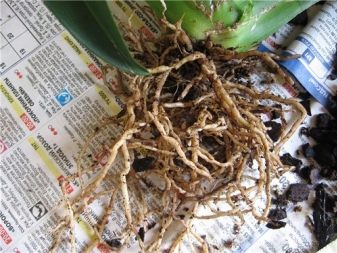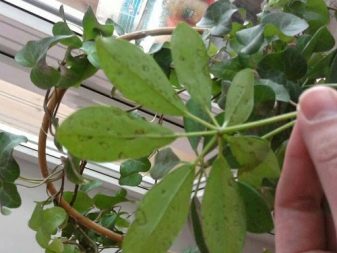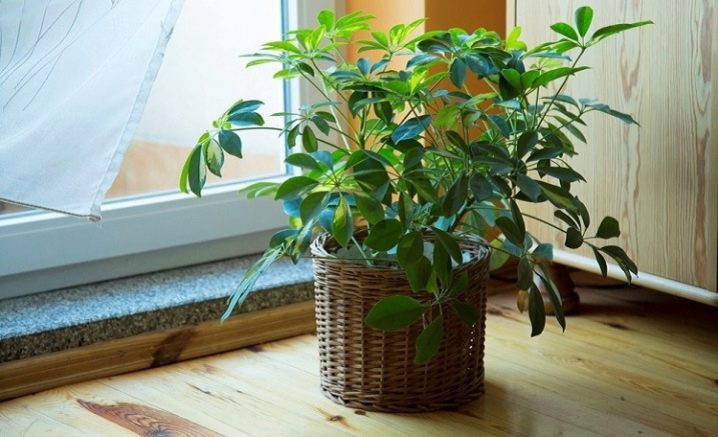Sheffler diseases and pests

Despite the fact that many amateur flower growers carefully and carefully follow all the recommendations for caring for a home plant, sometimes problems can still arise. But not always external signs and certain changes are harbingers of the disease. What ailments can a sheffler have, how to deal with them? All answers to these questions are already waiting for you in our special material.

Common diseases
With proper care and adherence to certain rules, a houseplant will delight you with its beauty all year round. Unfortunately, proper care is not a 100% guarantee that the flower will never get sick. Therefore, you need to carefully monitor the external changes of your favorite plant, which will allow you to solve the problem in a timely manner.
Lovers of this indoor plant are often faced with the fact that the flower has dropped its leaves., There are several reasons for this. The first is that the room is too hot and the humidity is low.
It is important to remember that this type of indoor plant loves moderate heat, that is, the temperature in the room should not exceed +22 degrees.


The second reason may be that the flower is cold. If the temperature is below +16 degrees, then the plant will begin to gradually shed its leaves. In addition, improper watering may be the reason. Due to excessive soil moisture, in the event of stagnation of water in a pot or in a pan, the plant will also begin to rapidly get rid of the leaves.
In the event that the leaves of a favorite plant become lighter, dull or turn yellow, then this indicates that the flower needs additional feeding. You do not need to do anything special to heal the plant. As a rule, complex fertilization can solve this problem. Try to feed 3 times a month. In this case, it is important to observe equal intervals between dressings. Remember that the shefflera is especially in need of feeding from April to September.
If the upper leaves begin to fade a little, then this indicates a lack of light. It is easy to get rid of this problem, you just need to find a comfortable place for the flower. It is important to remember that this species must be protected from direct sunlight, but it is also impossible to grow it in the shade.
It should be noted that the spotted shefflera, that is, a plant with variegated leaves, needs more lighting than a flower with uniform green leaves.


Sometimes brown spots begin to appear on the leaves of shefflers, as a result of which the leaves darken a lot, sometimes completely blacken, and the flower begins to die. Correct care will help to save the situation. This problem arises due to the fact that the roots of the house plant begin to gradually rot due to too much watering.
Most often, beginner growers encounter such a problem in the cold season., since from mid-autumn the number and volume of watering should be reduced. In addition, it is important to monitor the temperature of the water, as too cold water negatively affects the health of the plant's root system. It is important and timely to loosen the soil so that the roots of the flower receive a sufficient amount of oxygen.
In order to save rotting roots, you will have to carry out a simple healing procedure. It is necessary to rinse the roots of your favorite plant with a special antifungal agent. It can be easily found in any flower shop.Due to constant drafts and a sharp temperature drop, the leaves of this plant begin to darken at the edges. If you see that the edges of the leaves have dried up, have become darker, then move the plant to a more comfortable environment. Otherwise, the flower simply dies.


If you notice that the plant gradually withers, and the edges of the leaves become dry and dark, then this indicates that the flower is not receiving enough moisture. Be sure to follow the watering regime. The soil should be largely dry, and if the land is completely dry, then this already negatively affects the health of the sheffler. In addition, during the hot period, the plant needs frequent and regular spraying. Otherwise, due to a lack of moisture, the leaves will begin to dry, curl and fall off.
If you notice that a slight blackness has appeared on the stems of the flower, then this also indicates that you are watering the plant too abundantly. The result is mold and mildew. In this case, you should urgently check the root system for rot. In addition, you should cut off the tops of the spoiled stems and treat the plant with a special antifungal agent.


Pest control
It is not always possible to fully insure your favorite plant against the appearance of pests. Most often, it harms the leaves and stems of the sheffler scale insect. You can find out about this problem and take action in time if you pay attention to the obvious signs of the disease. These are sticky leaves, yellowing and leaf fall.
The upper stems of the flower may become more lethargic, the crown begins to slope downward and gradually withers... When the first signs appear, immediately isolate the flower so that pests cannot move to other indoor plants. After that, the plant must be thoroughly treated with soapy water.
Sometimes this type of indoor plant suffers from the appearance of the so-called spider mite. As a rule, such pests are found on plants that are kept in a room with too dry air. You may not notice the appearance of the pest itself, since the insect is very small. But as soon as you notice that a thin cobweb has appeared on the leaves, you should urgently take action. Otherwise, the plant will gradually wither and die.


To overcome the spider mite, you need to purchase a special drug that belongs to insecticides. In addition, you need to monitor the temperature and humidity levels in the room. If you notice a small insect with a white bloom on the leaves or stems, then this indicates that a mealybug has settled on the sheffler. First, remove all insects from the plant, then rinse the flower with water. Remember that this pest does not like water, so spray the flower regularly.
When brown spots appear on the plant, this indicates that thrips have settled on the flower. Isolate the sheffler urgently and treat the plant with soapy water.
After that, if necessary, you will need to treat the flower with an insecticide.

Tips & Tricks
Finally, I would like to share some useful recommendations, thanks to which it will be possible to preserve and maintain the health and beauty of your favorite flower.
- Many sheffler hobbyists start to worry about the fact that the young plant has too few leaves. But there is no need to worry, as this is quite normal for this type of home plant. As soon as the flower begins to mature, all the leaves will become the same size, and the plant will look beautiful.
- Sometimes flower growers are faced with such a problem when, as they grow, the leaves are formed at a great distance from each other, and the trunk of the plant is too elongated. Do not worry, as these are not signs of any disease. This suggests that the flower does not have enough light and is too hot. In this case, it is enough just to move the sheffler to more comfortable conditions for her, gradually the plant will become lush and healthy.

For information on how to properly transplant or plant Scheffler, see the video below.



























The comment was sent successfully.